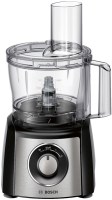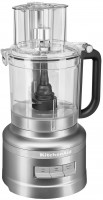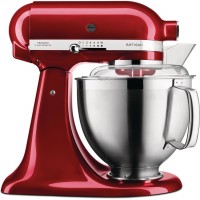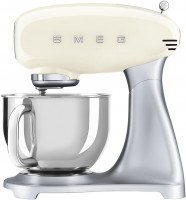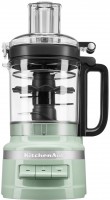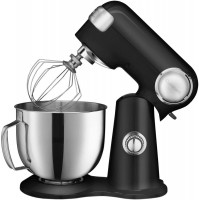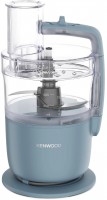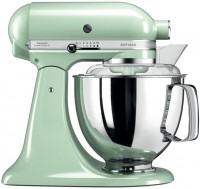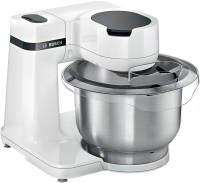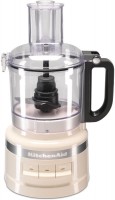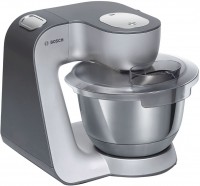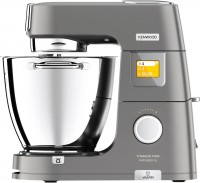Food Processors Smeg
All Food Processors Advanced filters → |
You might be interested in
Articles, reviews, useful tips
All materials
Immersion or countertop blenders – what is the difference and which is better?
For which tasks is it better to buy a countertop blender, and for which — an immersion one?

How to choose a mixer
The main parameters that will help you choose a mixer for your tasks
Food Processors: specifications, types
Type
— Food processor. A multifunctional device capable of performing a wide range of technological operations. A planetary mixer is usually the basis for them, you can connect many different attachments to it (blender, food processor, meat grinder). Thanks to this, the average food processor can: chop meat, grind mashed potatoes and pasta, squeeze juice, peel and cut vegetables, knead the dough , whip cream, etc. In choosing a food processor, you should pay attention to the equipment.The list of device functionality will depend on the number of nozzles.
— Kitchen machine. Universal devices, which in most cases are a combination of a blender and a food processor. However, the range of functionality of the equipment directly depends on the number and variety of complete nozzles. Usually, a kitchen machine performs the following operations: chopping meat and fish products, squeezing juice, peeling vegetables, grinding spices, etc., but they are practically not used for kneading dough.
— Planetary mixer. The device looks like a stationary mixer, but due to the planetary system of work and higher engine power, it is more efficient for mixing, whipping cream and kneading dough. For some planetary mixers, it is possible to buy and install additional accessories (blender, food processor, etc.), in which case the device will turn into a food processor.
– Steam blender.... The blender-steamer allows you to grind food to the desired consistency and immediately cook them for a couple. A design feature of such devices is the presence in the body of a compartment for filling water, which is heated by a heating element. Hot steam enters the bowl with chopped products through a hole in the bottom or side walls, during which steam cooking is ensured. Blenders-steamers are great for making mashed potatoes, as well as various baby food dishes while maintaining a maximum of vitamins and nutrients.
— Kitchen machine. Universal devices, which in most cases are a combination of a blender and a food processor. However, the range of functionality of the equipment directly depends on the number and variety of complete nozzles. Usually, a kitchen machine performs the following operations: chopping meat and fish products, squeezing juice, peeling vegetables, grinding spices, etc., but they are practically not used for kneading dough.
— Planetary mixer. The device looks like a stationary mixer, but due to the planetary system of work and higher engine power, it is more efficient for mixing, whipping cream and kneading dough. For some planetary mixers, it is possible to buy and install additional accessories (blender, food processor, etc.), in which case the device will turn into a food processor.
– Steam blender.... The blender-steamer allows you to grind food to the desired consistency and immediately cook them for a couple. A design feature of such devices is the presence in the body of a compartment for filling water, which is heated by a heating element. Hot steam enters the bowl with chopped products through a hole in the bottom or side walls, during which steam cooking is ensured. Blenders-steamers are great for making mashed potatoes, as well as various baby food dishes while maintaining a maximum of vitamins and nutrients.
Planetary mixing
Food processor support for planetary mixing mode. With such mixing, the working tool (whisk, spatula, etc.) not only rotates around its axis, but also moves around the centre of the bowl. This ensures the most balanced mixing, not only in the centre, but also along the edges of the container, and also speeds up the process. On the other hand, this function complicates the combine mechanism and requires a large bowl (at least 5 liters); all this has a effect on the price and dimensions of the device. Without exception, all planetary mixers and many models of food processors are endowed with such an opportunity.
Nozzles
— The main bowl. An open capacity designed for kneading dough, whipping cream and mixing masses. The main bowl is included in almost all food processors. It can be made of various materials: plastic, glass, metal, etc.
— Blender. In this case, it is a bowl narrowed downwards, at the bottom of which there is a bladed knife. Such a device is suitable both for mixing liquids into a homogeneous mass (for example, for making cocktails or batter), and for grinding some solid foods (for example, fruits and vegetables) into a homogeneous puree. The blender is usually installed instead of the main bowl, however, there are devices that allow you to use two bowls at the same time.
— Food processor. A special capacity for chopping, which is equipped with either a knife for chopping products, or discs for chopping, cutting, French fries. Allows you to cut salads, shred cabbage and perform a number of other operations, depending on the complete nozzles.
— End-to-end food processor. A special nozzle for installing cutting discs. This accessory allows you to quickly chop vegetables or shred cabbage. Moreover, the final product enters the main bowl (or any other from your kitchen inventory) — there is no separate bowl like in a classic food processor.
— Meat grinder. The possibility of using the device as a meat grinder...— for making minced meat, grinding fruits and vegetables. In terms of possibilities, such nozzles are often not inferior to meat grinders made in the form of separate devices.
— Vegetable cutter. A special attachment for cutting vegetables, fruits and mushrooms. Depending on the type, it allows you to cut food: into cubes, slices, sticks, etc. It can be equipped with its own capacity for collecting cuttings.
- Steam cooker. Ability to use the food processor as steam cooker — for steaming food. This method of cooking is considered healthier than classic cooking, it allows you to save a maximum of vitamins and nutrients in the products. Among other things, steaming is often used in the preparation of baby food. Some food processors with this function are originally designed specifically for cooking for children.
— Grinder(for coffee). The grinder with characteristic grinding rods for grinding grains (including coffee beans), oil seed crops, cereals and pulses. It is perfect for making flour. Ussually such attachments have opportunity to adjust the grinding degree.
— Centrifugal juicer. The universal juicer for getting fruit, vegetable and berry juice. Not suitable for citrus fruits (see Citrus juicer). Note that food processor juicers are usually less performant than juicers as separate devices, and therefore are poorly suited for harvesting large amounts of juice.
— Citrus juicer. It is a rotating ledge with a ribbed surface. To get juice, you need to manually put half of the fruit on it with the flesh down and press hard. Due to this procedure, the juice from the flesh is squeezed into the bowl located below, and the peel remains intact.
— Blender. In this case, it is a bowl narrowed downwards, at the bottom of which there is a bladed knife. Such a device is suitable both for mixing liquids into a homogeneous mass (for example, for making cocktails or batter), and for grinding some solid foods (for example, fruits and vegetables) into a homogeneous puree. The blender is usually installed instead of the main bowl, however, there are devices that allow you to use two bowls at the same time.
— Food processor. A special capacity for chopping, which is equipped with either a knife for chopping products, or discs for chopping, cutting, French fries. Allows you to cut salads, shred cabbage and perform a number of other operations, depending on the complete nozzles.
— End-to-end food processor. A special nozzle for installing cutting discs. This accessory allows you to quickly chop vegetables or shred cabbage. Moreover, the final product enters the main bowl (or any other from your kitchen inventory) — there is no separate bowl like in a classic food processor.
— Meat grinder. The possibility of using the device as a meat grinder...— for making minced meat, grinding fruits and vegetables. In terms of possibilities, such nozzles are often not inferior to meat grinders made in the form of separate devices.
— Vegetable cutter. A special attachment for cutting vegetables, fruits and mushrooms. Depending on the type, it allows you to cut food: into cubes, slices, sticks, etc. It can be equipped with its own capacity for collecting cuttings.
- Steam cooker. Ability to use the food processor as steam cooker — for steaming food. This method of cooking is considered healthier than classic cooking, it allows you to save a maximum of vitamins and nutrients in the products. Among other things, steaming is often used in the preparation of baby food. Some food processors with this function are originally designed specifically for cooking for children.
— Grinder(for coffee). The grinder with characteristic grinding rods for grinding grains (including coffee beans), oil seed crops, cereals and pulses. It is perfect for making flour. Ussually such attachments have opportunity to adjust the grinding degree.
— Centrifugal juicer. The universal juicer for getting fruit, vegetable and berry juice. Not suitable for citrus fruits (see Citrus juicer). Note that food processor juicers are usually less performant than juicers as separate devices, and therefore are poorly suited for harvesting large amounts of juice.
— Citrus juicer. It is a rotating ledge with a ribbed surface. To get juice, you need to manually put half of the fruit on it with the flesh down and press hard. Due to this procedure, the juice from the flesh is squeezed into the bowl located below, and the peel remains intact.
Installation of extra nozzles
Possibility of turning a planetary mixer into a food processor. Such devices have several shafts, when installed on which the relevant nozzles (available separately), you can add extra functions of a blender, food processor, meat grinder, etc. Accordingly , the installation of additional nozzles allows you to turn the planetary mixer into a food processor in the future.
Accessories
— The whisk . As the name implies, this attachment is designed for whipping and mixing "light" liquids (batter, mayonnaise, eggs, etc.). Most often the whisk is similar to that used in mixers (although there are other options). Sometimes there may be two such whisks.
— The hook for kneading dough. The attachment for kneading thick dough. It has a special shape, due to which the dough is evenly mixed, and there are no unused ingredients on the walls of the bowl.
— The double hook for kneading. The double hook allows you to significantly increase the efficiency of kneading thick dough. The second hook is used so that the dough does not stick to the bowl and mixes more thoroughly. Depending on the model, the double hook can be realized as a one hook or as a pieces of hook (two single kneading hooks) that can be used independently of each other.
— The spatula for mixing (bitter). The spatula for mixing is used in the making of light dough, confectionery mixtures, all kinds of pastas. Bitter can also simply mix various ingredients. It can be made of metal or plastic, as well as with additional rubber seal to prevent the product from sticking in the bowl.
— The disk for minced meat. Traditional grate grinder. The minced meat disk can have a different mesh size, from 3 to 8 m...m, which has a direct impact on the consistency of the cooked minced meat. Usually, three discs are included in the standard meat grinder set: for a fine fraction (cells are about 3 mm), for a medium fraction (about 5 mm) and for a large fraction (about 8 mm). Less commonly on the market there are also discs with smaller cells (1 mm or less), such are used for making pate.
— The attachment for kibbeh. Kibbeh is a dish of Arabic cuisine, which is a hollow sausage made of minced meat, which is stuffed with lumpy meat, vegetables and other products. After that, kibbeh are fried like meatballs or baked in the oven. The kibbeh attachment is fixed on the spout of the meat grinder, instead of the clamping ring for the grate, and allows you to quickly and easily form hollow sausages from minced meat.
— The attachment for homemade sausages. It is a thin-walled tube with a diameter of up to 20-30 mm and a length of 50 to 100 mm. The attachment is installed on the “spout” of the meat grinder, instead of the clamping ring for the mince/pate grate, and the edge of the membrane of the future sausage is put on the second end of the product. Thus, the attachment allows you to form homemade sausages, which are later fried or baked in the oven.
— For tomatoes/soft vegetables. The auger attachment for processing tomatoes and other soft vegetables or fruits, which effectively separates flesh from peel and tails. This is for making tomato juice or compotes at home.
— For pasta (macaroni). Wide popularity gained discs for making macaroni with openings of different calibres for certain types of pasta (tagliatelle, fettuccini, spaghetti and etc.).
— For cookies. The cooking attachment for cookies and pastry. It is a disc attachment with fixed plate with openings-patterns for forming curly dough. It is recommended to use low and medium speeds of the food processor for making the cookies.
— The chopper knife. The model is equipped with a knife for a food processor, which allows you to cut salads, shred cabbage and do a number of other operations.
— Disc for shredding/slicing. A disc with special slots that play the role of knives during rotation. Allows you to quickly and evenly cut fruits and vegetables into slices, especially useful for cutting large quantities of food.
— For dicing. The attachment for cutting fruits and vegetables in the form of small cubes. Great for cooking salads.
— The French fries disc. To make French fries, potatoes need to be cut in a special way — long thin sticks. The special disk, which is equipped with some food processors is for such cutting.
— For draniki (potato pancakes). Draniki, or potato pancakes, are pancakes that are made from mashed potatoes. The attachment for their cooking is usually a kind of "prickly" grater, which allows you to bring raw potatoes to the desired consistency. It can also be used for other purposes (for example, making applesauce).
— The disc for making sauces. A specialized attachment that allows you to grind semi-finished products into puree and making thick unigorm mixtures, such as sauces, creams, etc. It is a disk with special guides on the surface.
— The hook for kneading dough. The attachment for kneading thick dough. It has a special shape, due to which the dough is evenly mixed, and there are no unused ingredients on the walls of the bowl.
— The double hook for kneading. The double hook allows you to significantly increase the efficiency of kneading thick dough. The second hook is used so that the dough does not stick to the bowl and mixes more thoroughly. Depending on the model, the double hook can be realized as a one hook or as a pieces of hook (two single kneading hooks) that can be used independently of each other.
— The spatula for mixing (bitter). The spatula for mixing is used in the making of light dough, confectionery mixtures, all kinds of pastas. Bitter can also simply mix various ingredients. It can be made of metal or plastic, as well as with additional rubber seal to prevent the product from sticking in the bowl.
— The disk for minced meat. Traditional grate grinder. The minced meat disk can have a different mesh size, from 3 to 8 m...m, which has a direct impact on the consistency of the cooked minced meat. Usually, three discs are included in the standard meat grinder set: for a fine fraction (cells are about 3 mm), for a medium fraction (about 5 mm) and for a large fraction (about 8 mm). Less commonly on the market there are also discs with smaller cells (1 mm or less), such are used for making pate.
— The attachment for kibbeh. Kibbeh is a dish of Arabic cuisine, which is a hollow sausage made of minced meat, which is stuffed with lumpy meat, vegetables and other products. After that, kibbeh are fried like meatballs or baked in the oven. The kibbeh attachment is fixed on the spout of the meat grinder, instead of the clamping ring for the grate, and allows you to quickly and easily form hollow sausages from minced meat.
— The attachment for homemade sausages. It is a thin-walled tube with a diameter of up to 20-30 mm and a length of 50 to 100 mm. The attachment is installed on the “spout” of the meat grinder, instead of the clamping ring for the mince/pate grate, and the edge of the membrane of the future sausage is put on the second end of the product. Thus, the attachment allows you to form homemade sausages, which are later fried or baked in the oven.
— For tomatoes/soft vegetables. The auger attachment for processing tomatoes and other soft vegetables or fruits, which effectively separates flesh from peel and tails. This is for making tomato juice or compotes at home.
— For pasta (macaroni). Wide popularity gained discs for making macaroni with openings of different calibres for certain types of pasta (tagliatelle, fettuccini, spaghetti and etc.).
— For cookies. The cooking attachment for cookies and pastry. It is a disc attachment with fixed plate with openings-patterns for forming curly dough. It is recommended to use low and medium speeds of the food processor for making the cookies.
— The chopper knife. The model is equipped with a knife for a food processor, which allows you to cut salads, shred cabbage and do a number of other operations.
— Disc for shredding/slicing. A disc with special slots that play the role of knives during rotation. Allows you to quickly and evenly cut fruits and vegetables into slices, especially useful for cutting large quantities of food.
— For dicing. The attachment for cutting fruits and vegetables in the form of small cubes. Great for cooking salads.
— The French fries disc. To make French fries, potatoes need to be cut in a special way — long thin sticks. The special disk, which is equipped with some food processors is for such cutting.
— For draniki (potato pancakes). Draniki, or potato pancakes, are pancakes that are made from mashed potatoes. The attachment for their cooking is usually a kind of "prickly" grater, which allows you to bring raw potatoes to the desired consistency. It can also be used for other purposes (for example, making applesauce).
— The disc for making sauces. A specialized attachment that allows you to grind semi-finished products into puree and making thick unigorm mixtures, such as sauces, creams, etc. It is a disk with special guides on the surface.
Bowl capacity
The volume of the food bowl provided in the food processor. Most often the full volume is indicated, not the working volume. It should be noted that you can not use the bowl completely when cooking, the working volume is approximately 70% of the total. Thus, about 4 liters can be used in a 6 liter bowl. And if you go into the recipes and power modes of the food processor (see the instructions), then smaller numbers are acceptable for preparing a particular dish (kneading dough, mixing salad, etc.).
Note that a large capacity affects the dimensions and weight of the unit, and also requires a more powerful engine — which affects energy consumption and price. So when choosing a bowl by capacity, you should not chase the maximum capacity, but take into account the planned volumes of work.
Note that a large capacity affects the dimensions and weight of the unit, and also requires a more powerful engine — which affects energy consumption and price. So when choosing a bowl by capacity, you should not chase the maximum capacity, but take into account the planned volumes of work.
Chopping bowl capacity
The capacity of the blender bowl determines how much consistency the device can prepare in one approach. The average blender has a capacity of 1.5 liters, which is quite optimal for making drinks and other textures for three people.
Blender capacity
The volume of the blender jar (see Blender) that the food processor is equipped with. Standardly, it is about one and a half liters; for a large family, it makes sense to select a larger capacity (about 2 liters), and 1 liter will be enough if a blender is rarely needed and for small quantities of the product.
Power
Rated power of the food processor. Most of this power comes from the engine — the rest of the unit consumes very little energy. Usually, the more power, the higher the productivity of the unit, and the less time it takes to process products.
Note that the optimal power value directly depends on the volume of the bowl (see the relevant paragraph): for example, for a 1.5 kg bowl, at least 300 W is desirable, for a two-kilogram bowl — 400 W, a three-kilogram bowl — at least 700 W. And with the same bowl capacity, a more powerful unit will be more productive, it will work faster and better cope with high loads (for example, a full load). On the other hand, an increase in power affects energy consumption and price.
Note that the optimal power value directly depends on the volume of the bowl (see the relevant paragraph): for example, for a 1.5 kg bowl, at least 300 W is desirable, for a two-kilogram bowl — 400 W, a three-kilogram bowl — at least 700 W. And with the same bowl capacity, a more powerful unit will be more productive, it will work faster and better cope with high loads (for example, a full load). On the other hand, an increase in power affects energy consumption and price.
Max. revolutions
The maximum speed of rotation of the working attachment of the food processor. The higher the rotation speed, the more solid products can be processed in a food processor, and the less (in some cases) the time to complete the desired procedure.
Number of speeds
The number of fixed speeds of rotation of the attachments provided in the design of the food processor. The more of them, the more accurately you can choose the required speed for each specific mode of operation. It is worth noting that some devices do not have fixed speeds — the control is carried out smoothly (see Stepless speed controller)
Smooth speed control
A control that allows you to smoothly change the speed of rotation of the food processor engine — for more precise adjustment of speed and setting the optimal mode for different products. With stepwise speed control, a situation may arise when a higher speed value is already too high, and a lower speed is not yet enough. Smooth control avoids such situations.
Pulse mode
The ability to operate the food processor in pulsed mode, when the motor does not rotate constantly, but with pauses. This mode is particularly useful when processing hard foods, such as frozen fruits and vegetables, to ensure efficiency while reducing engine load.
Turbo mode
Turbo mode allows for a short time to increase greatly the speed of rotation of the food processor discs. This can be useful in dealing with hard products, such as making crushed ice or chopping vegetables. It will also come in handy in case of "congestion" at work — a short-term acceleration of the knife will help to cope with them. Keep in mind that the turbo mode is a kind of “emergency measure”, and not a regular mode, because the food processor engine in this mode works with significant loads. Therefore, you can turn it on only for a short time — otherwise there is a risk of damage to the device. Specific features of turbo modes differ from model to model and are usually indicated in the instruction manual.
Heating
The heating function in the food processor's working container is useful for certain recipes, especially when specific dough temperatures are needed or preheating the bowl is required. This feature is commonly found in models with a steam cooking mode, which involves exposing food to hot steam. As a result, the heating option is inherently present in all such models.
Timer
The timer allows you to set the time during which the device will perform a particular function; after a specified period of time is over, the device will automatically turn off. The food processor with a timer removes the need to monitor the operating time of the appliance and turn it off manually.
Kitchen scales
Availability in the food processor of the built-in kitchen scales. Usually, the weight sensor is built into the platform on which the bowl is installed; this allows you to determine the weight of the loaded products directly in the cooking process. Of course, other containers can be placed on such scales, not only the "native" bowl of the food processor.
Pre-installed programs
Automatic programs provided in the food processor to create some well-known and popular dishes.
Soup. The program is designed for cooking traditional soups which require the ingredients to be cut into small pieces and not mashed or blended. The program takes this into consideration and allows for the soup to be cooked directly in the device's bowl without having to unload the chopped ingredients.
— Puree. Automatic mode for the preparation of various purees — in particular, fruit and vegetable. Purees are usually thicker in texture than cream soups because they contain less liquid. Accordingly, more power is required for mashing.
— Sauces. The program is designed for preparing a variety of sauces and dressings. It includes a "Sauces" mode that is typically found in models equipped with an emulsion disc. This disc enables the user to grind the ingredients and create thick, homogeneous mixtures required for sauces and dressings.
— Smoothie. Program for making smoothie — thick drinks based on fruits, vegetables or berries with the addition of juice and various additional ingredients (milk, nuts, etc.). The consistency of a smoothie usually resembles juice with pulp or cream soup. However, the finished drink must be liquid enough to drink through a straw.
— Ice pick. The program is designed for creating ice crumbs from whole pieces of ice. To crush the ice, the program utilizes a pulsed mode as this process puts a signif...icant strain on the device's working nozzles.
— Self-cleaning. The program includes a self-cleaning function that allows the user to clean the bowl from dirt without having to remove it from the device. To use this function, warm soapy water is poured into the bowl and the program is activated. After completion, the water can be poured out and the bowl can be wiped clean. The self-cleaning function is much more convenient than manually washing the bowl in a sink, as it can reach even the most inaccessible corners to wash out food residues.
Soup. The program is designed for cooking traditional soups which require the ingredients to be cut into small pieces and not mashed or blended. The program takes this into consideration and allows for the soup to be cooked directly in the device's bowl without having to unload the chopped ingredients.
— Puree. Automatic mode for the preparation of various purees — in particular, fruit and vegetable. Purees are usually thicker in texture than cream soups because they contain less liquid. Accordingly, more power is required for mashing.
— Sauces. The program is designed for preparing a variety of sauces and dressings. It includes a "Sauces" mode that is typically found in models equipped with an emulsion disc. This disc enables the user to grind the ingredients and create thick, homogeneous mixtures required for sauces and dressings.
— Smoothie. Program for making smoothie — thick drinks based on fruits, vegetables or berries with the addition of juice and various additional ingredients (milk, nuts, etc.). The consistency of a smoothie usually resembles juice with pulp or cream soup. However, the finished drink must be liquid enough to drink through a straw.
— Ice pick. The program is designed for creating ice crumbs from whole pieces of ice. To crush the ice, the program utilizes a pulsed mode as this process puts a signif...icant strain on the device's working nozzles.
— Self-cleaning. The program includes a self-cleaning function that allows the user to clean the bowl from dirt without having to remove it from the device. To use this function, warm soapy water is poured into the bowl and the program is activated. After completion, the water can be poured out and the bowl can be wiped clean. The self-cleaning function is much more convenient than manually washing the bowl in a sink, as it can reach even the most inaccessible corners to wash out food residues.
Main bowl material
The bowls of modern food processors can be made of plastic, glass, or metal.
The plastic bowls are the most common due to their low cost and durability. They are lightweight, resistant to falls and can withstand quite large loads, they can be both transparent and opaque. The disadvantage of plastic is an increased tendency to scratches.
The glass bowls are scratch-resistant, and they allow you to monitor the products processing through transparency. However, the glass is a fragile material, and such bowls are very sensitive to falls, shaking, and bumps.
Metal (usually stainless steel) is the strongest and most durable material. However, it is opaque, in addition, the metal bowl usually significantly affects the cost of the device.
The plastic bowls are the most common due to their low cost and durability. They are lightweight, resistant to falls and can withstand quite large loads, they can be both transparent and opaque. The disadvantage of plastic is an increased tendency to scratches.
The glass bowls are scratch-resistant, and they allow you to monitor the products processing through transparency. However, the glass is a fragile material, and such bowls are very sensitive to falls, shaking, and bumps.
Metal (usually stainless steel) is the strongest and most durable material. However, it is opaque, in addition, the metal bowl usually significantly affects the cost of the device.
Blender bowl material
— The plastic blenders are the most common due to their low cost and durability. However, the material itself has a number of important advantages. So, it is easy to clean and dries quickly, plastic bowls can easily withstand a fall from a small height (up to 1-1.5 m) thanks to good margin of safety. Additionally, plastic bowls have a minimum cost. In the list of disadvantages, one can be noted the exposure to the rapid appearance of scratches and scuffs on the surface of the bowl.
— The glass blenders are resistant to scratches, and they allow you to monitor the process of processing products thanks to transparency. An important advantage of glass is the absolute chemical neutrality to foodstuffs and liquids. This material does not absorb odours, it can be washed in a dishwasher, the working surfaces of the bowl are practically not exposed to scratches and scuffs. Thus, glass bowls do not lose their original presentation over time. Among the disadvantages, fragility can be noted — glass does not tolerate falls even from a small height. Additionally, glass bowls are very expensive.
— Metal (most often it is stainless steel) is the most strong and durable material. However, it is opaque, and a metal blender usually affects the cost of the device. The metal bowls are perfect for crushing ice and crushing nuts. Such models are not afraid of falls from a heig...ht and rough handling, they can be freely washed in the dishwasher.
— The glass blenders are resistant to scratches, and they allow you to monitor the process of processing products thanks to transparency. An important advantage of glass is the absolute chemical neutrality to foodstuffs and liquids. This material does not absorb odours, it can be washed in a dishwasher, the working surfaces of the bowl are practically not exposed to scratches and scuffs. Thus, glass bowls do not lose their original presentation over time. Among the disadvantages, fragility can be noted — glass does not tolerate falls even from a small height. Additionally, glass bowls are very expensive.
— Metal (most often it is stainless steel) is the most strong and durable material. However, it is opaque, and a metal blender usually affects the cost of the device. The metal bowls are perfect for crushing ice and crushing nuts. Such models are not afraid of falls from a heig...ht and rough handling, they can be freely washed in the dishwasher.
Body material
The main material used for the body of the unit.
— Plastic. The main advantage of plastic is the relatively low cost. In addition, this material can have almost any colour, including quite bright ones. In terms of strength and reliability, the plastic is inferior to metal, but this difference does not play a special role in normal use, it becomes noticeable only in various emergency situations (during falls, overheating, etc.). Also, plastic bodies are relatively easy to scratch, but this point mainly affects the appearance of the unit and does not affect the functionality. In light of all this, only plastic is the most popular material for the bodies of modern food processors.
— Metal. Metal bodies are distinguished by their solid appearance and high strength. On the other hand, this material is noticeably more expensive than plastic, and therefore is less common — mainly in middle and high class food processors.
— Plastic. The main advantage of plastic is the relatively low cost. In addition, this material can have almost any colour, including quite bright ones. In terms of strength and reliability, the plastic is inferior to metal, but this difference does not play a special role in normal use, it becomes noticeable only in various emergency situations (during falls, overheating, etc.). Also, plastic bodies are relatively easy to scratch, but this point mainly affects the appearance of the unit and does not affect the functionality. In light of all this, only plastic is the most popular material for the bodies of modern food processors.
— Metal. Metal bodies are distinguished by their solid appearance and high strength. On the other hand, this material is noticeably more expensive than plastic, and therefore is less common — mainly in middle and high class food processors.
Display
Availability of the display on the control panel makes operation of the device more simple and visual. Usually, the screen displays basic information about the operating modes used, and the display is also used for setting parameters.
Section/stand for attachments
The presence in the body of the device of a separate section for replaceable attachments, or a appliance for storing them directly in the working bowl of the device. Such food processors are more convenient in storage, because they are less bulky, take up less space, and the risk of losing any attachment is reduced.
Section for cord
A special section in the body of the device for storing the power cord. Often such sections are also come with devices for uniform winding of the wire, which prevents bending and possible fractures. The cord section is especially useful if the food processor is used relatively rarely and stands idle for a long time outside the kitchen.


